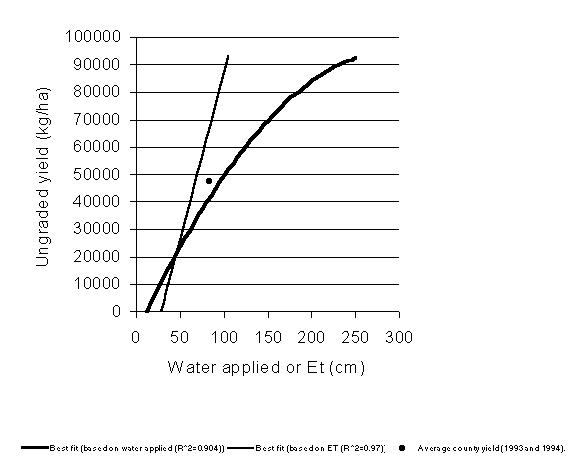Onions
Water Production Function
New Mexico Crop Information Onion Water Production function or the relationship between Water applied or evapotranspiration (Et) and yield. Research conducted at Las Cruces, NM Irrigation efficiency ranged from 80-85 percent at low yield and 60-70 percent at high yield. Onions are shallow rooted and the drip system was buried with a large amount of water applied going to deep drainage.

Yield = -7809.23+693.5 water-applied -1.164water-applied^2 Yield= -35300 + 1224.2 Et
The coefficient of determination is 0.90
Yield of onions versus water applied (excluding rain) for the year 1994-1996
The reference for this work is M. S. Al-Jamal, T. W. Samm S. Ball and D. Smeal, 1999. Computing the crop water production function for onions. Submitted to Ag Water Management.
New Mexico Onions
Joe Corgan, Professor Department of Agronomy and Horticulture
The present NMSU Experiment Station program seeks to improve varieties for resistance to bolting (seedstalk production), resistance to pink root disease, improved handling characteristics, and cold hardiness. We are also concentrating efforts to develop improved varieties with low pungency, so the New Mexico industry can promote and market a sweet onion from June through August.
Presented below is a list of Onion varieties released by the NMSU onion breeding program since 1980, suggested planting dates, and approximate harvest dates at Las Cruces, NM.
Suggested planting and approximate harvest dates are for Las Cruces, New Mexico. The planting dates apply throughout southern New Mexico, but the harvest dates will be different according to location. In general, harvest dates are about 5 to 7 days later in the Hatch area, and 10 to 14 days later in the Deming and Uvas areas. Losses of over-wintering plants to winter-killing in the Deming and Uvas areas may dictate the earliest possible planting dates for the fall-planted varieties. Earlier planted onions attain larger size before winter, enhancing their survival potential.